Biography :
Yinka Shonibare MBE ( The Most excellent Order of the British Empire ).Born February 10,1962) is a British-Nigerian conceptual artist. Yinka Shonibare is a senior figure in the British art world but one who intentionally eludes easy categorization. He calls himself a "postcolonial hybrid."
Erudite and wide ranging, Mr. Shonibare, is a disabled black artist who continuously challenges assumptions and stereotypes. He makes art that is sumptuously aesthetic beautiful and draws you in and often wickedly funny. When he deals with pithy matters like race, class, disability, colonialism and war, he does so deftly and often indirectly. (New York Times)
Yinka Shonibare is a painter, photographer and installation artist, whose art is influenced by both the cultures of Nigeria, where he grew up, and Britain, where he was born , studied and now lives. He has exhibited widely all over the world.Shonibare's videos, photographs and installations playfully mix up cultural and historical signifiers to blur boundaries between class and ethnicity, high and low art and coloniser-colonised relationships. Since the 1990s Shonibare has exhibited internationally extensively, including the Venice Biennale, 2001, and Documenta 11, Kassel, in 2002. In 2004 he was nominated for the Turner Prize.
Background:
He was born in London in 1962 of Nigerian parents who moved back to Lagos when the artist was three, Shonibare has always straddled different identities, both national and physical. Son of an upper middle-class lawyer, his brothers are a surgeon and a banker, his sister is a dentist. It would be something of an understatement to say that his parents were appalled when he started talking about wanting to be an artist. "I was a freak! Success is so important in Nigeria. When you're some young, tramp artist, you're considered a drop-out."
He summered in London and Battersea, attended an exclusive boarding school in England at age sixteen (where much to his amusement he learned that his classmates assumed that all black people are poor), and enrolled in Byam Shaw School of Art, London (now part of Central Saint Martin's College of Art and Design) at age nineteen. One month into his art school studies he contracted a virus that rendered him paralyzed. After three years of physical therapy, Shonibare remains partially disabled.
These dual identities--African/British; physically able/challenged--are only two of Shonibare's acknowledged hybrid conditions.
His paintings and his sculptural installations make extensive use of dyed fabrics, which became popular in West Africa after independence. But many of these textiles betray Indonesian influences, are manufactured in Holland and are purchased by the artist in Brixton in south London. The complexities of nationality and identity, of history and ethnicity, post-colonialism and today’s global economy, form the intellectual and aesthetic arena in which Shonibare works
His works have a strongly contemporary feel, but at the same time they engage with the traditions and masterworks of western art history. The results are witty and playful, sensuous and poetic.
Yinka Shonibare's work takes us on a roller-coaster ride through our own history, from colonisation to space exploration, taking in literary works and modern art, and all the while collapsing the idea of national identity, authenticity and cultural ownership.
Shonibare parodies European culture and cultural works in photographic tableaux and three-dimensional sculpted figures, dressed in or made of such 'traditional African' fabrics as batik — which actually originated in Indonesia and was exported around the world by Dutch and British colonists, and which the artist now buys at Brixton market in south London. But Shonibare does not use parody for its own sake. He is interested in the resonances of combinations of seemingly incompatible elements within a strong western tradition.
In Shonibare's world (and, he encourages us to suspect, in our own), cultures and histories shift about. Western thought's monolithic sense of itself is undermined. New ways of thinking about the world, relating to history, race, ethnicity and culture, are introduced in a riot of colour and with humour. This is a non-didactic political art which creates questions in the mind rather than simply posing and answering a political point.
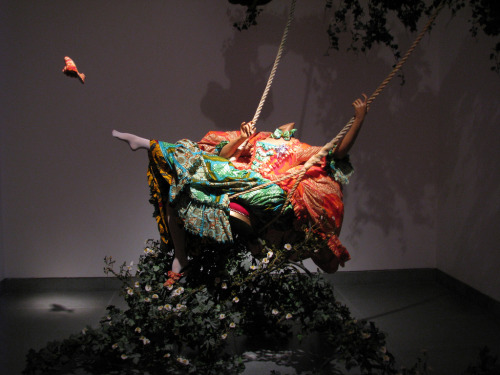
Shonibare uses the same distinctive fabric in his sculptures and installations to make copies of European costumes and furnishings. In The Swing (after Fragonard), Shonibare creates a sculpture of the central figure in Jean-Honore Fragonard’s 1776 painting. To many, the original painting represents the frivolous spirit and loose morality of French aristocracy shortly before the revolution. However, Shonibare’s work is not just a parody of the original: “I made a piece of work about this painting because I actually admire the work very much,” he says. “And I like the contradiction of taking something that’s supposedly ‘ethnic’ and putting that onto classical European painting.”
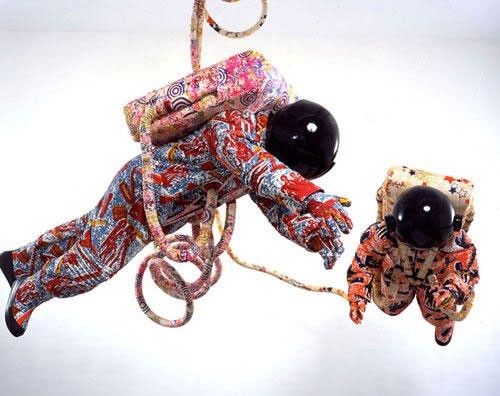
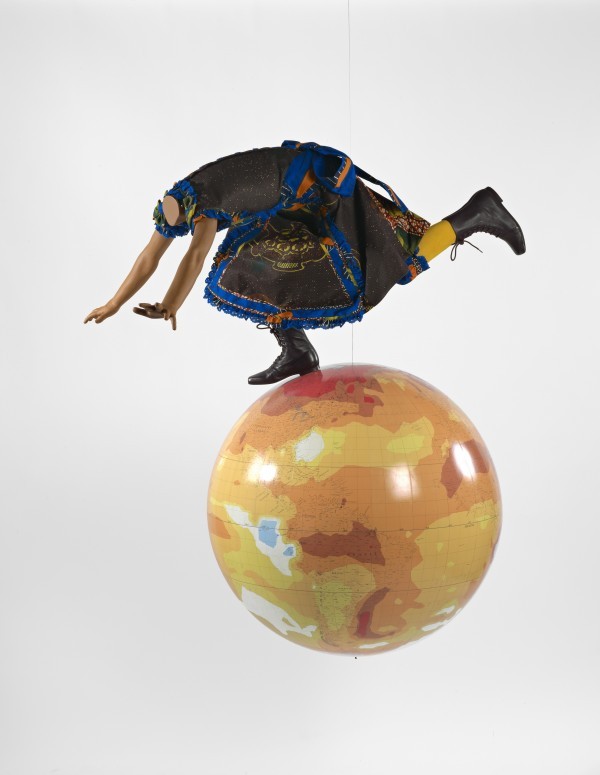
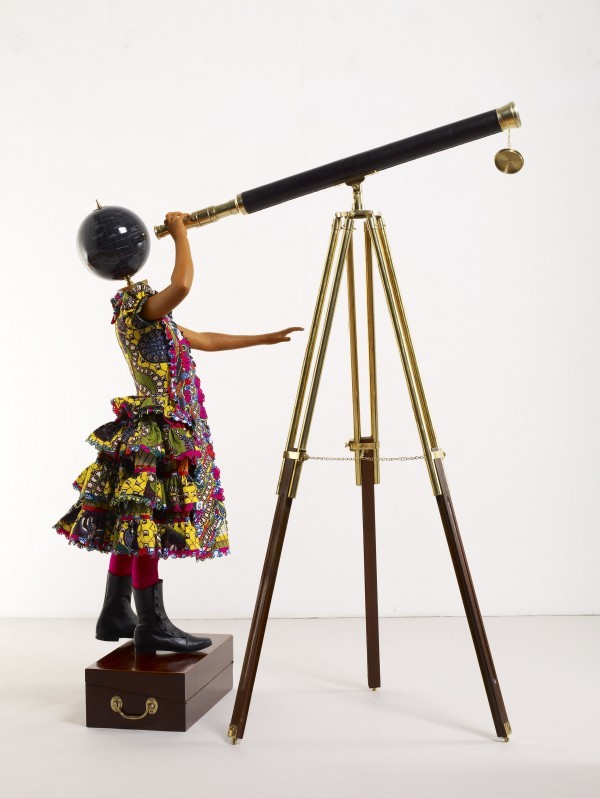
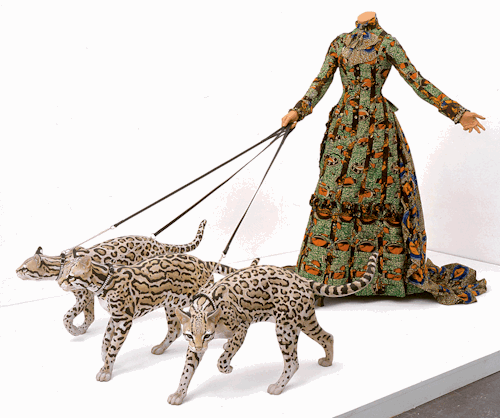
Work Citied:http://www.africansuccess.org/visuFiche.php?id=193&lang=en
Photos: http://ornamentedbeing.tumblr.com/post/5675994465
Yinka Shonibare MBE ( The Most excellent Order of the British Empire ).Born February 10,1962) is a British-Nigerian conceptual artist. Yinka Shonibare is a senior figure in the British art world but one who intentionally eludes easy categorization. He calls himself a "postcolonial hybrid."
Erudite and wide ranging, Mr. Shonibare, is a disabled black artist who continuously challenges assumptions and stereotypes. He makes art that is sumptuously aesthetic beautiful and draws you in and often wickedly funny. When he deals with pithy matters like race, class, disability, colonialism and war, he does so deftly and often indirectly. (New York Times)
Yinka Shonibare is a painter, photographer and installation artist, whose art is influenced by both the cultures of Nigeria, where he grew up, and Britain, where he was born , studied and now lives. He has exhibited widely all over the world.Shonibare's videos, photographs and installations playfully mix up cultural and historical signifiers to blur boundaries between class and ethnicity, high and low art and coloniser-colonised relationships. Since the 1990s Shonibare has exhibited internationally extensively, including the Venice Biennale, 2001, and Documenta 11, Kassel, in 2002. In 2004 he was nominated for the Turner Prize.
Background:
He was born in London in 1962 of Nigerian parents who moved back to Lagos when the artist was three, Shonibare has always straddled different identities, both national and physical. Son of an upper middle-class lawyer, his brothers are a surgeon and a banker, his sister is a dentist. It would be something of an understatement to say that his parents were appalled when he started talking about wanting to be an artist. "I was a freak! Success is so important in Nigeria. When you're some young, tramp artist, you're considered a drop-out."
He summered in London and Battersea, attended an exclusive boarding school in England at age sixteen (where much to his amusement he learned that his classmates assumed that all black people are poor), and enrolled in Byam Shaw School of Art, London (now part of Central Saint Martin's College of Art and Design) at age nineteen. One month into his art school studies he contracted a virus that rendered him paralyzed. After three years of physical therapy, Shonibare remains partially disabled.
These dual identities--African/British; physically able/challenged--are only two of Shonibare's acknowledged hybrid conditions.
His paintings and his sculptural installations make extensive use of dyed fabrics, which became popular in West Africa after independence. But many of these textiles betray Indonesian influences, are manufactured in Holland and are purchased by the artist in Brixton in south London. The complexities of nationality and identity, of history and ethnicity, post-colonialism and today’s global economy, form the intellectual and aesthetic arena in which Shonibare works
His works have a strongly contemporary feel, but at the same time they engage with the traditions and masterworks of western art history. The results are witty and playful, sensuous and poetic.
Yinka Shonibare's work takes us on a roller-coaster ride through our own history, from colonisation to space exploration, taking in literary works and modern art, and all the while collapsing the idea of national identity, authenticity and cultural ownership.
Shonibare parodies European culture and cultural works in photographic tableaux and three-dimensional sculpted figures, dressed in or made of such 'traditional African' fabrics as batik — which actually originated in Indonesia and was exported around the world by Dutch and British colonists, and which the artist now buys at Brixton market in south London. But Shonibare does not use parody for its own sake. He is interested in the resonances of combinations of seemingly incompatible elements within a strong western tradition.
In Shonibare's world (and, he encourages us to suspect, in our own), cultures and histories shift about. Western thought's monolithic sense of itself is undermined. New ways of thinking about the world, relating to history, race, ethnicity and culture, are introduced in a riot of colour and with humour. This is a non-didactic political art which creates questions in the mind rather than simply posing and answering a political point.

Shonibare uses the same distinctive fabric in his sculptures and installations to make copies of European costumes and furnishings. In The Swing (after Fragonard), Shonibare creates a sculpture of the central figure in Jean-Honore Fragonard’s 1776 painting. To many, the original painting represents the frivolous spirit and loose morality of French aristocracy shortly before the revolution. However, Shonibare’s work is not just a parody of the original: “I made a piece of work about this painting because I actually admire the work very much,” he says. “And I like the contradiction of taking something that’s supposedly ‘ethnic’ and putting that onto classical European painting.”




Work Citied:http://www.africansuccess.org/visuFiche.php?id=193&lang=en
Photos: http://ornamentedbeing.tumblr.com/post/5675994465
No comments:
Post a Comment